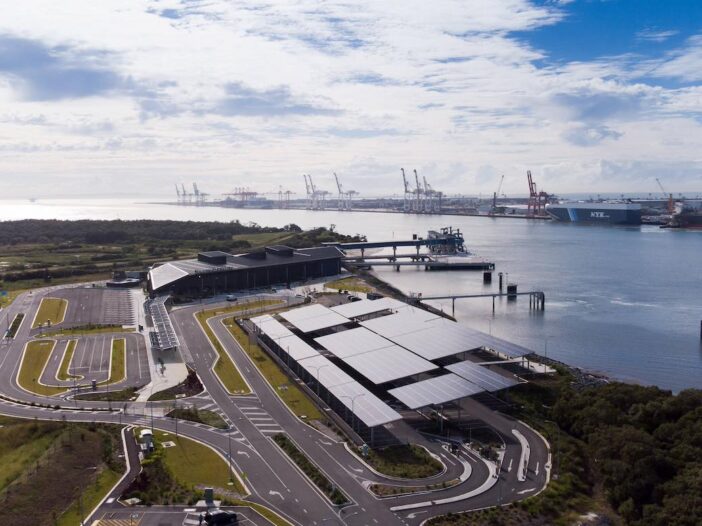
Queensland shipping and logistics giant the Port of Brisbane has tapped the services of Tasmanian renewables-focused retailer Momentum Energy, through a deal that allows it to “share” the excess solar generated at one of its sites across the rest of its operations.
Momentum said this week it has signed up the Port of Brisbane Pty Ltd (PBPL) as the first official customer of its Virtual Energy Network (VEN) offering, which aims to help commercial and industrial customers go big on solar, while also maximising self consumption.
The VEN offering specifically targets commercial and industrial businesses that produce more solar than they can use at a single location, while having other locations that perhaps can’t host their own solar array, for logistical or economic reasons.
The Port of Brisbane ticks the box, with 800kW of solar that was installed at its International Cruise Terminal when it was built in 2020 – including the solar shade carport pictured above – regularly generating more electricity than it can use at the passenger terminal.
Using the Enosi Powertracer Platform, the VEN collects the data from smart meters at all Port of Brisbane sites, matching the solar exports with the grid imports every thirty minutes.
In this way Momentum financially offsets the excess solar produced at the Port of Brisbane terminal against the energy used at other PBPL-operated sites, thus replacing what would be a small feed-in tariff with more cheap solar.
Cam Taylor, Momentum’s head of energy solutions, says the new contract with the Port Brisbane follows “a bit of trial” period, where the retailer has been working at getting the proposition right, getting feedback from customers and making sure the commercials work.
“We’re at a stage now where we’re really happy with it, seeing good results and good feedback from customers,” he told One Step Off The Grid on Thursday.
“And so we’re looking to go more broadly with the [commercial and industrial VEN] offering, but also we’re shortly going to be expanding into [small to medium enterprises].”
Port of Brisbane executive general manager of sustainability, Brendan Connell, says PBPL – which is owned by the APH Consortium comprising four of the world’s largest infrastructure investors – was happy with initial trials and has extended its VEN contract for a further 33 months.
“When we built the Brisbane International Cruise Terminal, we installed an 800kW rooftop solar system but it generated more electricity – around 1400 MWh – than we were able to use at the terminal itself,” Connell said.
“Now the VEN is established, we’re sharing the benefits of that solar power across our own facilities. It’s supporting our Net Zero ambitions and demonstrating our sustainability commitment to our customers and stakeholders.”
But Taylor says it’s important to stress that the VEN won’t suit all customers. “It suits the customers that that are exporting, number one, but also importing during those … same [30 minute] windows at other sites,” he says.
“We work with Enosi, who have the power tracer platform that digests all of that smart meter [data] and essentially is able to match that energy on that basis and and we can reward customers that are able to match export and import.”
“And at the customer level, if this product is really incentivising them to be shifting their load to times of the day where there’s lots of solar out there, I think that can only be a good thing.”
Momentum’s managing director Lisa Chiba says that while the Port of Brisbane VEN is about maximising the benefits of an existing solar installation, other businesses might use it to invest in bigger solar systems than originally planned.
“With a faster return on investment, Momentum’s VEN might incentivise C&I customers to invest in solar on a much larger scale than they normally would,” Chiba says.
“Momentum is proud to support our C&I customers embrace the benefits of large scale solar and help them play a part in the energy transition.”
In the case of the Port of Brisbane, which has a net zero emissions target set for 2030, the deal with Momentum also includes a Corporate Power Purchase Agreement (CPPA) through which it buys renewable energy certificates (LGCs) from the Granville Harbour Wind Farm in Tasmania.
The 112MW Granville Harbour wind farm was initially developed by Westcoast Wind, which was bought out by Palisade in 2018, some months after the two companies negotiated a long-term PPA for the wind farm’s output with Hydro Tasmania. https://reneweconomy.com.au/tasmanias-granville-harbour-wind-farm-now-sending-power-to-the-grid-16893/
“The CPPA is, I guess, a more robust way for [PBPL] to offset their emissions, whereas the virtual energy network is a way for them to be able to visualise the sharing of solar across their network,” Taylor says.
“We’ve seen lots of interest in [the VEN] from the customers we have spoken to and and now that we’re trying to go a bit more broad with it and let people know that this is a possibility … hopefully we will see lots more interest.”

Sophie is editor of One Step Off The Grid and deputy editor of its sister site, Renew Economy. Sophie has been writing about clean energy for more than a decade.



